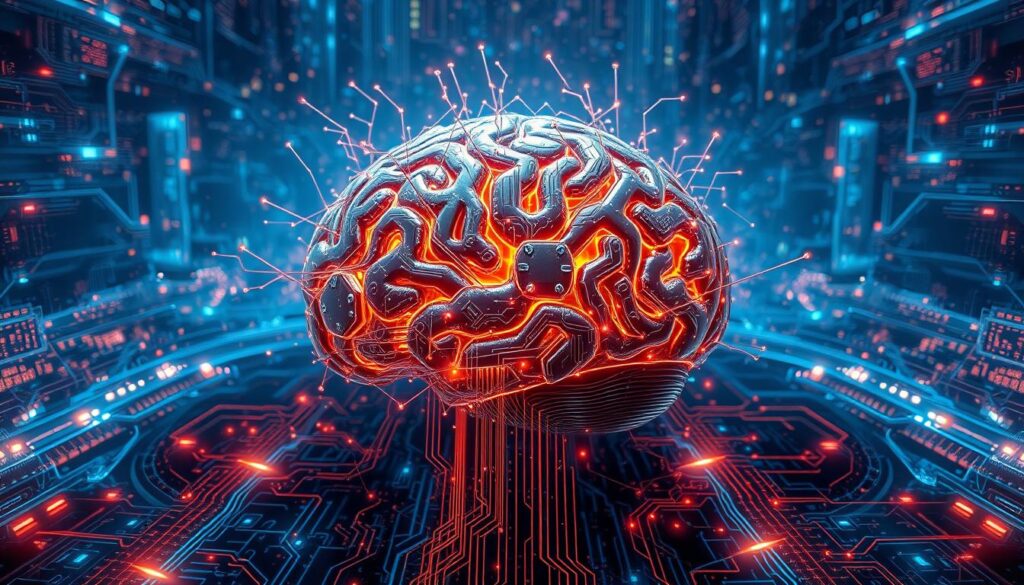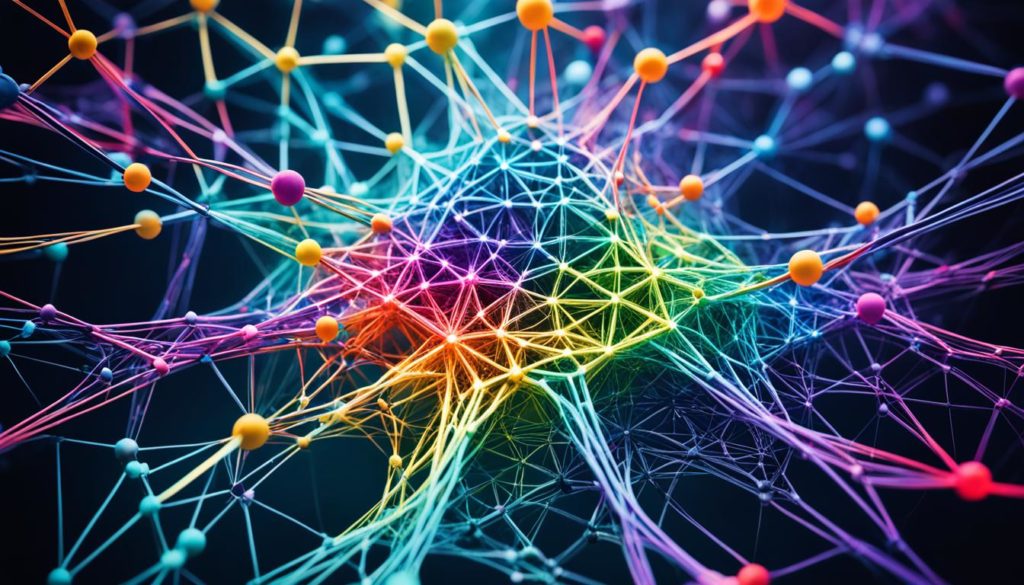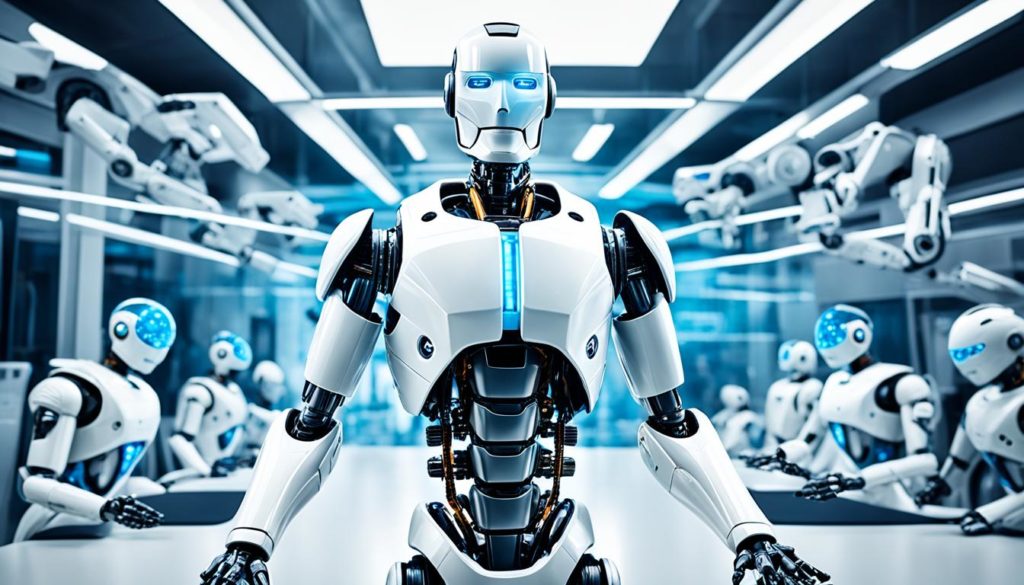
Did you know neuromorphic computing systems can cut power use by up to 1000 times? They do this by copying the brain’s neural structure. This uses artificial neurons and synapses to process info like our brains do.
This new way of computing, called neuromorphic computing, could change many areas. It’s set to transform fields like artificial intelligence, self-driving cars, and space travel.
Understanding how neuromorphic computing works is key. It mimics the brain’s neural networks. This makes it great for handling lots of data quickly and using less energy. It’s changing healthcare and making self-driving cars better.
Key Takeaways
- Neuromorphic computing mimics the neural architecture of the human brain, utilizing artificial neurons and synapses.
- It significantly reduces power consumption compared to traditional computing systems.
- Spiking neural networks (SNNs) in neuromorphic systems enhance the handling of temporal information for tasks like pattern recognition.
- Memristors in neuromorphic systems enable dynamic learning and adaptation over time.
- Neuromorphic computing holds promise for advanced AI applications and real-time data processing, vital for fields like space exploration and autonomous vehicles.
What is Neuromorphic Computing?
Neuromorphic computing is a new way of making computers. It uses electronic parts that work like the brain’s cells. This makes computers better at handling lots of data.
Definition and Basics
This field takes a lot from how our brains work. About 80% of projects use brain-like ideas. For example, MIT made a chip in 2011 that mimics brain signals with 400 transistors.
Stanford’s Neurogrid uses 16 special chips to mimic 65,536 neurons. This shows how far brain-inspired computing has come.
Brain-Inspired Architecture
Neuromorphic systems are getting better at solving complex problems. The European Commission gave $1.3 billion to the Human Brain Project. Intel also made a chip called “Loihi” in 2017 for faster computing.
Projects like IMEC’s OxRAM chip and the Blue Brain Project are pushing the limits. The SpiNNaker system and BrainScaleS machine show how far we’ve come.
| Project/Initiative | Key Features |
|---|---|
| Neurogrid | 65,536 Neurons with analog circuitry |
| Loihi by Intel | SNN-based for self-modifying computations |
| Human Brain Project | $1.3 Billion investment by the European Commission |
| Blue Brain Project | Simulations of the mouse brain |
| SpiNNaker System | Real-time processing with 1 million ARM processors |
| BrainScaleS Machine | Neural emulation at 1,000x real-time speed |
Neuromorphic computing is changing technology. It’s making computers smarter and more efficient.
The Technology Behind Neuromorphic Computing
Neuromorphic computing is at the crossroads of brain science and advanced hardware. It uses brain-like designs to change how we process information. Artificial neurons and synapses work like their real counterparts, making processing fast and learning flexible.
Universities, the U.S. military, and tech giants like Intel Labs and IBM are diving into this field. They aim to beat Moore’s Law limits. Stanford University’s Neurogrid is a big win, simulating a million neurons and billions of connections in real-time.
Neurons and Synapses
Neuromorphic hardware is based on neural networks. It uses spiking neural networks (SNN) to mimic brain cells and connections. Unlike old computers, neuromorphic systems mix processing and memory in each neuron. This makes them super efficient and saves a lot of energy.
Advantages Over Traditional Computing
Neuromorphic computing beats old computers in many ways. It’s much better at saving energy. Old computers have separate parts for processing and memory, which wastes energy and slows things down. New processors like Intel’s Loihi 2 and IBM’s TrueNorth are much more efficient and flexible.
| Aspect | Neuromorphic Computing | Traditional Computing |
|---|---|---|
| Processing Unit | Integrated Neurons | Separate CPU |
| Energy Efficiency | High | Low |
| Data Handling | Massively Parallel | Sequential |
| Adaptability | Dynamic Learning | Static |
As we delve deeper into brain science, neuromorphic computing is set to change AI and autonomous systems. Its efficiency promises new tech and sustainable computing options.
Applications in Artificial Intelligence and Machine Learning
Neuromorphic computing is changing artificial intelligence and machine learning. It uses a brain-like design. This technology is making big changes in healthcare and transportation.
Healthcare Innovations
AI and machine learning are making medical diagnosis better. Neuromorphic computing helps these systems look at medical images in new ways. This helps doctors find diseases that are hard to spot, improving care.
Places like Caltech, MIT, and Stanford University are leading in this field. They are working on systems that use less energy but handle lots of data well. This is great for AI in healthcare.
Advancements in Autonomous Vehicles
Neuromorphic computing is also key for self-driving cars. It helps these cars make quick decisions by processing lots of data. For example, Intel’s Loihi chip shows how fast and useful this tech is.
Neuromorphic computing lets self-driving cars understand sensor data fast. This makes driving safer and more efficient. It’s changing how we travel.
Neuromorphic Computing in Cognitive Computing
Neuromorphic computing is set to boost cognitive computing by improving real-time data analysis. Chips like Intel’s Loihi and IBM’s TrueNorth mimic the brain’s structure. They use spiking neural networks to handle lots of information at once.
Neuromorphic computing and cognitive computing work well together. They are energy-efficient and handle data quickly. This is great for systems that need fast data processing.
For example, IBM Watson uses neuromorphic tech to make smart decisions. This tech helps systems like Watson work better and faster.
Also, neuromorphic computing is key for AI. It supports learning from small data sets and without supervision. Neuromorphic chips use less power and process data faster than traditional computers.
This is important for edge computing, brain-computer interfaces, and adaptive robotics.
Here’s a comparison of capabilities and applications of neuromorphic and cognitive computing:
| Feature | Neuromorphic Computing | Cognitive Computing |
|---|---|---|
| Primary Architecture | SNNs, spike-based | Software-based, neural networks |
| Applications | Robotics, BCIs, Edge computing | Healthcare, Finance, Customer Service |
| Energy Efficiency | Ultra-low power consumption | Higher power demands |
| Data Processing | Real-time, sensory inputs | Decision-making, problem-solving |
Neuromorphic computing has its challenges, like developing hardware and software. But its impact on AI and machine learning is huge. As it improves, we’ll see more of it by 2025, changing how we compute and think.
Current State of Neuromorphic Computing Development
Neuromorphic computing is advancing fast, thanks to IBM and Intel. They’re making chips that work like our brains. These chips could change how we use computers by using less energy and doing more.
Key Players in the Industry
IBM and Intel lead in neuromorphic computing. IBM’s TrueNorth chip is a big deal. It uses very little energy to mimic millions of brain cells.
Intel’s Loihi 2 is also a standout. It’s designed for AI tasks and is very efficient.
Academic and government projects like The Human Brain Project in Europe are also key. They’re working on understanding the brain with neuromorphic computing. Their BrainScaleS supercomputer is a big step forward.
Recent Breakthroughs
New advancements in neuromorphic computing are exciting. Researchers have made chips that use almost as little energy as our brains. This is thanks to new technology.
These chips only work when needed, unlike old computers. This makes them more efficient and saves energy.
Computing power is growing fast, and neuromorphic computing is a green solution. It could help us use less energy in the future. With new materials, the future of brain-like computers looks bright.
| Neuromorphic Processor | Key Features |
|---|---|
| IBM TrueNorth | Simulates millions of neurons and billions of synapses with low energy consumption |
| Intel Loihi 2 | Advanced architecture, robust performance, efficient for AI tasks |
| BrainScaleS | Scalable neuromorphic emulation developed by The Human Brain Project |
Challenges of Neuromorphic Computing
Neuromorphic computing holds great promise but faces many computing challenges. Designing and making these complex systems is very hard. They have about 5×10^8 transistors/cm^2 and 10^10 synapses/cm^2.
Creating algorithms to manage these networks is also a big challenge. This makes it tough to get them to work right.
The lack of industry standardization is a big barrier to technology adoption. Unlike traditional computing, neuromorphic systems don’t have clear rules. This makes it hard for researchers and developers to work together.
Understanding how the brain works is also a problem. Projects like DARPA’s SyNAPSE aim for 10^6 neuron simulations but struggle to define complete biological models.
Another big issue is power consumption, especially for off-chip memory. Data centers use a lot of energy, about 200 terawatt-hours a year. The human brain uses only 20 W.
As data centers’ energy needs could grow tenfold by 2030, this is a pressing problem. Neuromorphic systems use more power because they need lots of memory bandwidth.
To make neuromorphic computing work, we need more investment in tools and skills. We must tackle challenges in real-world systems and understand complex structures better. Intel, IBM, and the Neuromorphic Computing Lab at ETH Zurich are leading the way.
But, solving these problems will take teamwork from experts in algorithms, architecture, and hardware.
Future Implications of Neuromorphic Computing
The future of neuromorphic computing is exciting. It’s inspired by the human brain and could change our world. It’s set to blend with new technologies.
Integration with Emerging Technologies
Neuromorphic computing will team up with quantum computing integration and blockchain. This mix could make things much more efficient. For example, IBM’s TrueNorth chip has a million neurons and 256 million synapses.
Neuromorphic chips also use much less energy than old chips. This is a big step towards saving energy. Companies like Intel and IBM are investing heavily in this area.
Intel is spending $7 billion to improve its chip-making. IBM is working on big projects with DARPA and the Department of Energy. By 2021, we might see a supercomputer as powerful as the human brain.
The neuromorphic chip market is expected to grow a lot. It could reach $1.78 billion by 2025. By 2029, it might even hit $5.83 billion.
For more insights, you can also read this article about neuromorphic computing and its future implications.
Potential for Space Applications
Neuromorphic computing is great for space. It’s high-performance and can handle tough conditions. It’s perfect for AI in space tasks like finding objects and controlling systems.
These chips use much less power than old systems. They can learn and adapt like the human brain. This makes space missions better.
Neuromorphic chips are great for space because they use less power. They can handle information in both directions. This makes them perfect for space tasks.
Companies like NASA and private ventures are using neuromorphic computing. This technology is not just for exploring space. It’s about changing how we interact with it.
Conclusion
Neuromorphic computing is changing the game in artificial intelligence and machine learning. It works like the human brain, making information processing more efficient. This new way of computing could lead to big changes in how we use technology.
This technology is set to make a big impact in many areas. Companies like Intel and IBM are leading the way. They’re working on making systems that can handle lots of tasks at once, like recognizing images and understanding language.
Neuromorphic computing is key for things like self-driving cars and better healthcare. It’s also great for keeping an eye on the environment in real-time. But, there are still hurdles to overcome, like making the technology more efficient and standardizing it.
Despite these challenges, the progress is exciting. It shows that neuromorphic computing could help solve big problems like climate change and economic inequality. For more on this, check out this article.
In short, neuromorphic computing is on the rise. It’s bringing new levels of efficiency and innovation to many fields. As research continues, we can expect even more exciting breakthroughs.
FAQ
What is neuromorphic computing?
Neuromorphic computing is a way to make computers work like our brains. It uses artificial neurons and synapses instead of traditional transistors. This makes computers more efficient and powerful.
How does neuromorphic computing differ from traditional computing?
Traditional computers process data one step at a time. Neuromorphic computers do it all at once, thanks to artificial neurons and synapses. This makes them learn and adapt, using less energy and being more powerful.
What are the key benefits of neuromorphic computing?
Neuromorphic computing is very energy-efficient and powerful. It’s great for recognizing patterns and analyzing data in real-time. This makes it perfect for many industries, like healthcare and space exploration.
What industries could benefit from neuromorphic computing?
Healthcare, transportation, and cognitive computing can all use neuromorphic computing. It helps with better medical diagnosis, improves self-driving cars, and makes quick decisions in complex systems.
Who are the key players in the neuromorphic computing industry?
Big names like IBM and Intel are leading in neuromorphic computing. They have developed processors like IBM’s TrueNorth and Intel’s Loihi 2. The Human Brain Project in the EU is also making big strides with their BrainScaleS supercomputer.
What challenges does neuromorphic computing face?
Designing and making neuromorphic systems is very complex. There’s also a need for standard protocols and understanding the brain better. Overcoming these challenges will take teamwork and a lot of research and investment.
How is neuromorphic computing expected to shape the future of technology?
Neuromorphic computing will change AI and many industries with its energy-efficient and powerful solutions. It will work with new tech like quantum computing and blockchain. It will also lead to new discoveries in space.
What are some recent breakthroughs in neuromorphic computing?
IBM’s TrueNorth and Intel’s Loihi 2 are recent achievements. These chips are very energy-efficient and have advanced neuron-synapse designs. They’re setting the stage for more advanced computing systems.
How does neuromorphic computing contribute to advancements in artificial intelligence?
Neuromorphic computing helps AI by recognizing patterns and analyzing data in real-time. This is key for AI to think like humans. It makes AI systems more efficient and able to make decisions on their own.
What potential applications does neuromorphic computing have in space?
In space, neuromorphic computing can spot objects and changes, control robots, and learn on its own. Its high-performance and ability to work in harsh conditions make it perfect for space missions. It opens up new possibilities for AI in space.
Future App Studios is an award-winning software development & outsourcing company. Our team of experts is ready to craft the solution your company needs.










